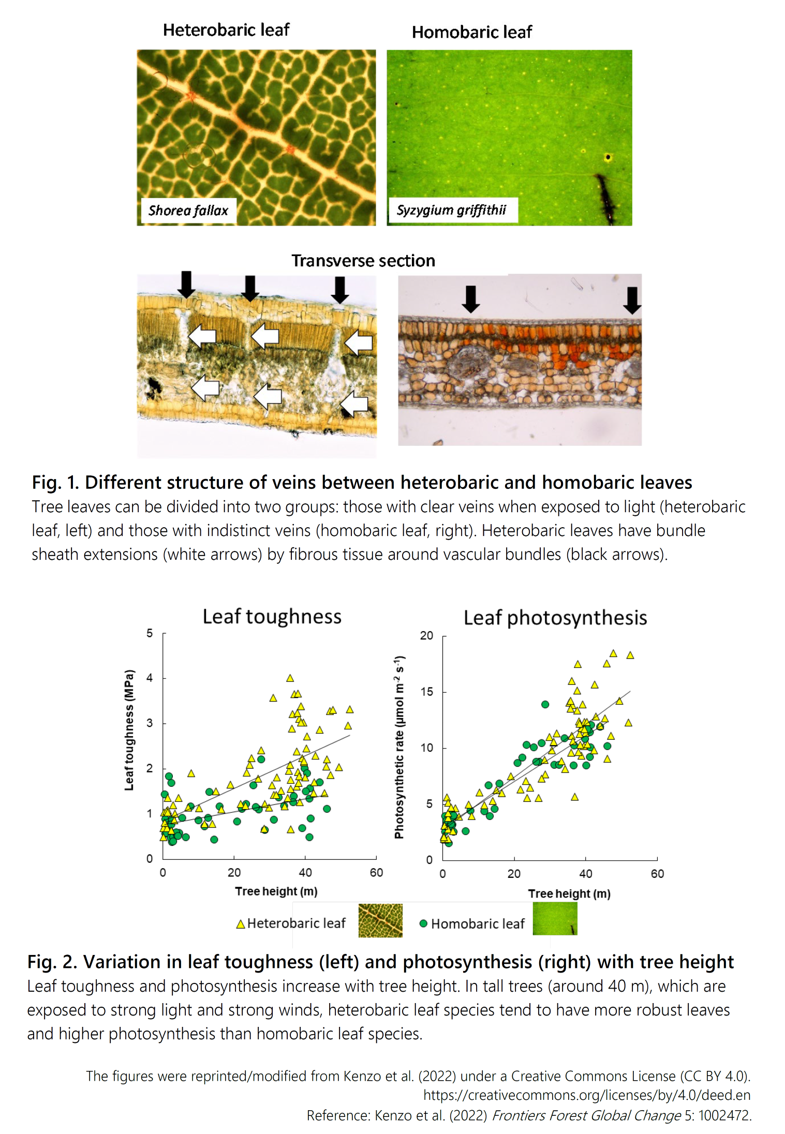Vein structure is related to leaf toughness and photosynthetic capacity in tropical forest trees
Description
Tropical rainforests in Southeast Asia absorb carbon dioxide through high photosynthetic activity and are essential for mitigating climate change. However, they have been degraded by excessive logging, and thus there is a need to restore forest resources through tree planting. In order to ensure successful planting, it is necessary to select tree species suitable for planting environment of the degraded forest through understanding of tree ecological traits such as stress tolerance.
To understand tree ecological traits, we focus on leaf vein structure, which is easy to observe, and develop a method to easily identify tree traits based on leaf morphology in Malaysian tropical rainforest. Tree leaves can be classified into two types of vein structure: leaves with a clearly visible vein network are called heterobaric leaf, while leaves with an indistinct vein network are called homobaric leaf. The former has a transparent fibrous tissue around the veins, which allows light to penetrate, while the latter lacks this tissue (Fig. 1). Leaf toughness and photosynthesis increase with height regardless of species and are related to vein structure (Fig. 2). In taller and brighter environments, heterobaric leaves are more robust and have high photosynthetic ability compared with homobaric leaves. Taller tree species have a higher proportion of heterobaric leaves, while shrubby species tend to have homobaric leaves. Heterobaric leaves are stronger due to their fibrous tissue and higher photosynthesis making them advantageous in environments where leaf defense is required. Homobaric leaves, on the other hand, have much amount of photosynthetic cells instead of fibrous tissue, which allows them to utilize weak light more efficiently, thus favoring photosynthesis in dark environments.
Overall, the leaf vein structure can be used as a convenient indicator for selecting herbivore-tolerant and shade-tolerant tree species from diverse tropical rainforest species. However, it should be noted that a tree's ability to adapt to its environment is not determined solely by the vein structure. For example, tolerance to cold and drought is likely to be related to other traits such as wood density, and thus it is necessary to improve the indicator such as combination with vein structure.
Figure, table
- Research project
- Program name
- Term of research
-
FY2021–2022
- Responsible researcher
-
Tanaka Kenzo ( Forestry Division )
KAKEN Researcher No.: 30414486Mohizah Mohamad ( Forest Department Sarawak, Malaysia )
Ichie Tomoaki ( Kochi University )
ORCID ID0000-0002-1979-5806KAKEN Researcher No.: 80403872 - ほか
- Publication, etc.
-
Kenzo et al. (2022) Frontiers Forest Global Change 5:1002472.https://doi.org/10.3389/ffgc.2022.1002472
- Japanese PDF
-
2022_A08_ja.pdf1.09 MB
- English PDF
-
2022_A08_en.pdf556.62 KB
* Affiliation at the time of implementation of the study.

